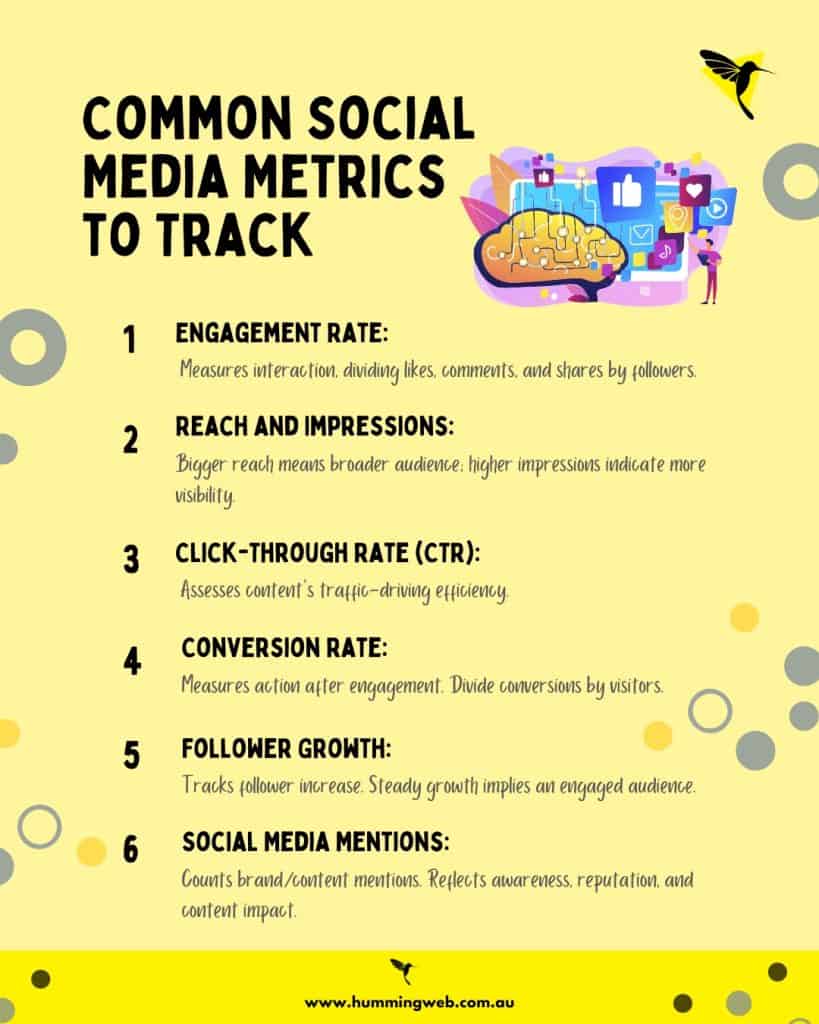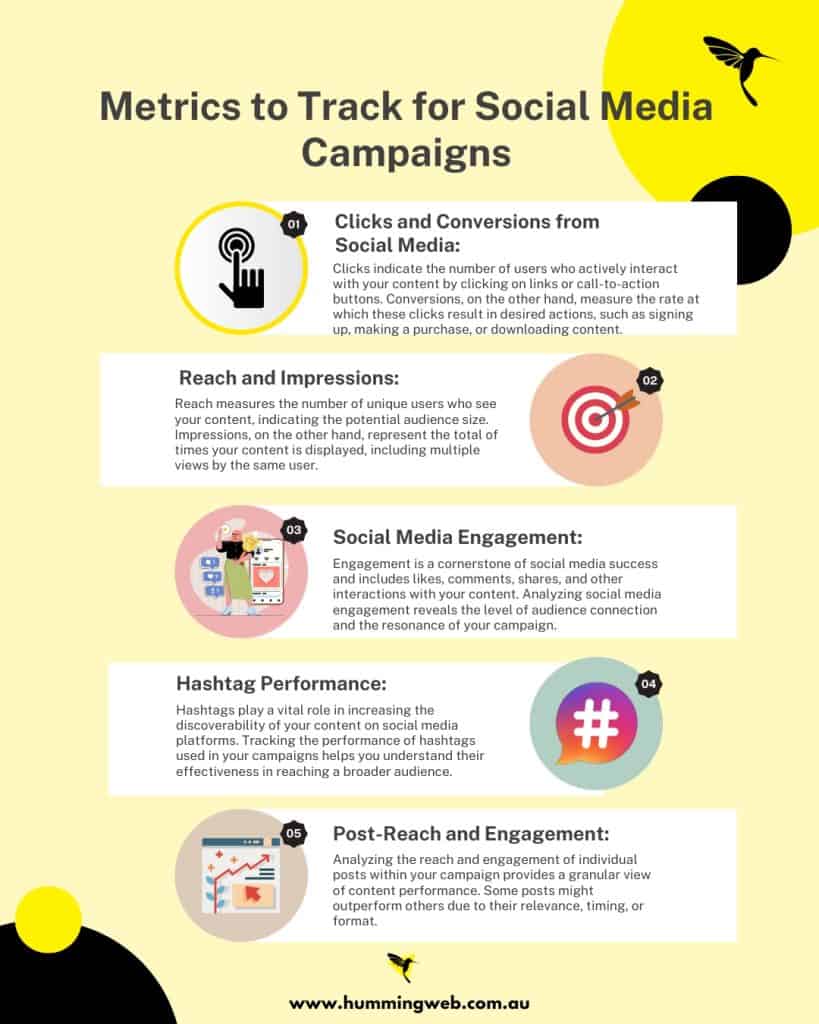Social media has become an integral part of our daily lives, with millions of users engaging on various platforms. It has opened up new avenues for promotion and brand awareness for businesses and marketers. But how can we measure the success of our social media efforts? This article will explore the metrics and tools to track and measure social media accomplishments.
What Are Social Media Metrics?

Social media metrics are quantifiable measures used to analyze and track the performance of your social media marketing efforts. These metrics provide valuable insights into the effectiveness of your campaigns and help you gauge the impact of your strategies.
Understanding the Importance of Social Media Metrics
Measuring social media metrics is crucial for any business or marketer looking to leverage the power of social media. It allows you to assess the reach, engagement, and impact of your social media campaigns, helping you make data-driven decisions and optimize your strategies to achieve better results.
INSTAGRAM FEED
If you encounter any issues or have specific requirements, feel free to provide more details,
and we can offer more tailored assistance.
Common Social Media Metrics to Track
There are several metrics you need to track to measure your social media accomplishment. These include but are not limited to:
- 1. Engagement Rate: This metric gauges the level of interaction your content receives, reflecting its resonance with your audience. Calculated by dividing total engagements (likes, comments, shares) by total followers, a higher engagement rate signifies stronger audience connection and content quality.
- 2. Reach and Impressions: Reach measures the unique users exposed to your content, while impressions indicate the total number of times it’s displayed. A larger reach signifies a broader audience reach, while higher impressions show increased content visibility. Both metrics help assess your content’s distribution and overall visibility.
- 3. Click-Through Rate (CTR): CTR evaluates the effectiveness of your content in driving traffic to desired destinations. It’s determined by dividing the number of clicks on your link by the total number of times the link was shown. A higher CTR indicates compelling content that successfully encourages users to take action.
- 4. Conversion Rate: The conversion rate measures the proportion of users who perform a desired action (like making a purchase or signing up) after engaging with your content. Calculated by dividing conversions by total visitors, a higher conversion rate reflects the persuasiveness of your content and its ability to drive desired outcomes.
- 5. Follower Growth: Follower growth tracks the increase in your social media followers over a specific period. A steady growth rate implies an expanding and engaged audience. However, focusing solely on numbers may not reflect true engagement; combining this with engagement rate provides a more comprehensive view of your audience’s quality.
- 6. Social Media Mentions: This metric quantifies how often your brand or content is mentioned across social platforms. It reflects brand awareness, reputation, and the level of conversations your content generates. Monitoring mentions helps identify trends, gauge sentiment, and adapt strategies to enhance your brand’s online presence.

How to Set Social Media Metrics Goals
Before diving into tracking social media metrics, it’s essential to set specific and measurable goals. Determine what you want to achieve through your social media efforts, whether it’s increasing brand awareness, driving website traffic, or generating leads. Once you have defined your goals, you can identify the metrics that align with them and track your progress accordingly.
Tools for Tracking Social Media Metrics
Tracking social media metrics can be overwhelming without the right tools. Fortunately, there are several social media measurement instruments available that can simplify the process and provide you with valuable insights. Here are some popular tools you can utilize:
A Comprehensive Guide to Analytics Tools
- 1. Google Analytics: A robust web analytics platform, Google Analytics offers a comprehensive view of website traffic and referral sources. It provides profound insights into the origin of visitors and their behavior, making it indispensable for monitoring social media-driven traffic and evaluating conversion rates. By understanding user interactions and traffic patterns, businesses can optimize their online strategies, ensuring effective engagement and enhancing overall digital performance.
2. Sprout Social: Serving as an integrated social media management solution, Sprout Social presents a suite of tools to assess engagement metrics, decipher audience demographics, and analyze content efficacy. With its user-friendly interface, it becomes a pivotal aid in refining online strategies. By leveraging its insights, businesses can fine-tune their content, resonate more effectively with their target audience, and foster meaningful interactions, thereby nurturing a robust online community.
3. Hootsuite: Hootsuite emerges as a versatile social media scheduling and monitoring platform. It extends valuable post-performance analytics, illuminates audience engagement trends, and facilitates competitor tracking. Employed wisely, it streamlines the management of social media activities. This enables brands to maintain a consistent and impactful online presence, gauge content resonance, and stay attuned to the competitive landscape, thereby enhancing strategic decision-making and fortifying brand identity. Having these tools at your disposal can greatly enhance your ability to track and analyze social media metrics, enabling data-driven decisions and improved campaign performance.
Top Free Analytics Tools
If you’re on a budget, there are also many ways to measure the performance of your free social media tools that can provide you with basic tracking capabilities. Tools like Facebook Insights, Twitter Analytics, and Instagram Insights allow you to monitor your social media metrics without any additional cost.
1. Facebook Insights: Available for free from Facebook, Insights is a vital tool for businesses with Facebook Pages. It grants access to detailed analytics concerning page and post-performance. Through Insights, one can monitor metrics such as engagement rates, reach, and audience demographics. This comprehensive data enables businesses to refine their content strategy and tailor it to their followers’ preferences, fostering higher engagement and better connections. With no additional cost, Insights empowers businesses to enhance their Facebook presence efficiently.
2. Twitter Analytics: A valuable resource for Twitter users, Twitter Analytics is offered at no expense. It provides an array of insights into tweet performance and audience engagement. By tracking metrics such as retweets, likes, and follower growth, businesses can measure the resonance of their content and gauge the effectiveness of their Twitter strategies. This tool aids in understanding which content garners the most attention and helps refine posting tactics to align with audience preferences, all without straining the budget.
3. Instagram Insights: Integrated seamlessly within Instagram Business accounts, Instagram Insights offers businesses a trove of data about their performance. From post engagement and reach to follower demographics, this tool empowers businesses to understand their audience better. Metrics like story views, profile visits, and content interactions provide a comprehensive view of how users are interacting with the content. This knowledge guides content creation and helps refine engagement strategies to maximize the impact of Instagram marketing efforts, all without incurring any extra costs.
4. LinkedIn Analytics: Integrated within both personal and business profiles on LinkedIn, this feature provides invaluable insights. It offers data on post reach, engagement levels, and follower demographics. By understanding post-performance, professionals can tailor content to their audience’s preferences and optimize engagement. The availability of these metrics within the platform eliminates the need for extra expenses, enabling effective post-analysis without financial burden.
5. YouTube Analytics: For content creators on YouTube, the platform’s built-in data analysis tool, YouTube Analytics, is invaluable. It delves deep into video performance, including metrics like views, watch time, and audience demographics. This information guides creators in refining content strategies and understanding viewer behavior. Without any additional cost, YouTube Analytics empowers channel owners to monitor their performance, improve content quality, and enhance engagement.
Paid Social Analytics Tools for In-Depth Analysis
For more in-depth analysis and advanced features, paid tools can be a valuable investment. Platforms like Sprout Social, Brandwatch, and Buffer can track your social media reporting and analytics capabilities, allowing you to gain deeper insights into your social media performance.
- 1. Sprout Social: A sophisticated social media management solution, Sprout Social offers advanced analytics for businesses. Its comprehensive suite includes features like post-performance metrics, audience demographics, and competitor tracking. This detailed data empowers businesses to fine-tune their content strategies, understand their audience deeply, and stay informed about industry trends. By providing a holistic view of social media activities, Sprout Social equips brands with insights for effective engagement and strategic decision-making.
2. Brandwatch: Positioned as a premium social media intelligence platform, Brandwatch goes beyond basic analytics. It employs powerful AI and data analysis to track sentiment, brand mentions, and consumer insights across social platforms and the web. This enables businesses to monitor their brand reputation, understand consumer opinions, and uncover emerging trends. With its advanced capabilities, Brandwatch helps companies make data-driven decisions, enhance their brand image, and respond effectively to market shifts.
3. Buffer: Alongside its scheduling features, Buffer provides advanced social media analytics that dives into post-performance and engagement metrics. Beyond the basics, Buffer’s analytics offer a deeper understanding of audience behavior and preferences. This data aids in optimizing content strategy and engagement tactics. Buffer’s advanced analytics empower businesses to refine their social media efforts, ensuring that they are delivering content that resonates with their audience and drives meaningful interactions.
Social Media Measurement in Campaign Performance
Running an Online Strategy is a common practice for businesses and marketers to achieve their marketing goals. However, measuring the success of these campaigns is essential to determine their effectiveness. Here are some key metrics to track for online strategies:
Metrics to Track for Social Media Campaigns
When evaluating the performance of your online promotion, there are several metrics you need to pay attention to:

Clicks and Conversions from Social Media: Monitoring clicks and conversions is essential to gauge the effectiveness of your Strategy. Clicks indicate the number of users who actively interact with your content by clicking on links or call-to-action buttons. Conversions, on the other hand, measure the rate at which these clicks result in desired actions, such as signing up, making a purchase, or downloading content. Tracking these metrics helps you understand if your content is compelling enough to drive users to take meaningful steps. Analyzing which posts or campaigns generate the most clicks and conversions provides insights into audience preferences and can guide future campaign strategies.
Reach and Impressions: Reach and impressions provide valuable information about the extent of your campaign’s visibility. Reach measures the number of unique users who see your content, indicating the potential audience size. Impressions, on the other hand, represent the total of times your content is displayed, including multiple views by the same user. These metrics help assess the reach of your campaign and its overall impact. A higher reach signifies effective content distribution, while a higher impression count indicates strong content visibility. By comparing these metrics, you can determine the efficiency of your content in capturing audience attention.
Social Media Engagement: Engagement is a cornerstone of social media success and includes likes, comments, shares, and other interactions with your content. Analyzing social media engagement reveals the level of audience connection and the resonance of your campaign. High engagement signifies that your content is resonating with your audience and sparking conversations. It also fosters a sense of community and brand loyalty. By analyzing the type of content that garners the most engagement and the sentiment of comments, you can refine your strategy to consistently engage your audience.
Hashtag Performance: Hashtags play a vital role in increasing the discoverability of your content on social media platforms. Tracking the performance of hashtags used in your campaigns helps you understand their effectiveness in reaching a broader audience. Look at the engagement, reach, and impressions associated with specific hashtags. Are certain hashtags consistently driving higher engagement? Are there trends in the type of content that performs well with specific hashtags? Adjust your hashtag strategy based on these insights to optimize your campaign’s visibility and appeal.
Post-Reach and Engagement: Analyzing the reach and engagement of individual posts within your campaign provides a granular view of content performance. Some posts might outperform others due to their relevance, timing, or format. By evaluating the reach and engagement of each post, you can identify trends and patterns that inform your content creation and posting schedule. This approach allows you to refine your campaign strategy in real time, capitalizing on what’s resonating with your audience and making necessary adjustments to maximize the overall impact of your social media promotion.
Conclusion
In conclusion, measuring and tracking metrics is essential for social media success. By analyzing data such as reach, and conversions, businesses can evaluate the effectiveness of their social media strategies. Regularly monitoring these metrics allows for adjustments and optimizations to improve performance. Along with a deep understanding of target audience demographics and preferences, social media managers can utilize these measurements to guide their content creation and engagement strategies. In the constantly evolving world of social media, staying updated and utilizing the right metrics is crucial for achieving meaningful results.


